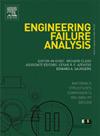Investigation of high‑temperature tensile damage behavior and fracture mechanisms in DC53 tool steel
IF 5.7
2区 工程技术
Q1 ENGINEERING, MECHANICAL
引用次数: 0
Abstract
To elucidate the high-temperature damage and fracture mechanisms of DC53 tool steel during cutter ring hot forming, high-temperature tensile tests were performed on notched specimens. Instead of a single condition, a range of temperatures (1000–1060 °C), strain rates (0.05–5 s−1), and notch radii (2.5–30 mm) was investigated. The fracture morphologies and microstructures of the specimens were examined using optical microscopy and scanning electron microscopy. The results show that the peak tensile load of DC53 steel increases with decreasing temperature and increasing strain rate. Its ductility and fracture strain are enhanced with increasing temperature and strain rate. Under low stress triaxiality, DC53 steel exhibits pronounced brittleness. With increasing temperature and strain rate, the fracture mechanism gradually shifts from brittle to ductile. At low stress triaxiality, dynamic recrystallization is suppressed, resulting in coarse intergranular fracture features and a significant reduction in ductility. Voids preferentially nucleate at carbides, while their growth and coalescence are significantly inhibited under conditions of intensive dynamic recrystallization. Based on these findings, a high-temperature damage and fracture model for DC53 tool steel is proposed.
DC53工具钢高温拉伸损伤行为及断裂机制研究
为了阐明DC53工具钢在刀环热成形过程中的高温损伤和断裂机理,对切槽试样进行了高温拉伸试验。与单一条件不同,研究了温度(1000-1060°C)、应变速率(0.05-5 s−1)和缺口半径(2.5-30 mm)的范围。采用光学显微镜和扫描电镜对试样的断口形貌和显微组织进行了观察。结果表明:DC53钢的峰值拉伸载荷随温度的降低和应变速率的增大而增大;随着温度和应变速率的升高,其塑性和断裂应变得到增强。在低应力三轴性下,DC53钢表现出明显的脆性。随着温度和应变速率的升高,断裂机制逐渐由脆性向延性转变。在低应力三轴状态下,动态再结晶受到抑制,导致粗晶间断裂特征和延性显著降低。在剧烈的动态再结晶条件下,孔洞优先在碳化物处成核,而孔洞的生长和聚结受到明显抑制。在此基础上,建立了DC53工具钢的高温损伤断裂模型。
本文章由计算机程序翻译,如有差异,请以英文原文为准。
求助全文
约1分钟内获得全文
求助全文
来源期刊

Engineering Failure Analysis
工程技术-材料科学:表征与测试
CiteScore
7.70
自引率
20.00%
发文量
956
审稿时长
47 days
期刊介绍:
Engineering Failure Analysis publishes research papers describing the analysis of engineering failures and related studies.
Papers relating to the structure, properties and behaviour of engineering materials are encouraged, particularly those which also involve the detailed application of materials parameters to problems in engineering structures, components and design. In addition to the area of materials engineering, the interacting fields of mechanical, manufacturing, aeronautical, civil, chemical, corrosion and design engineering are considered relevant. Activity should be directed at analysing engineering failures and carrying out research to help reduce the incidences of failures and to extend the operating horizons of engineering materials.
Emphasis is placed on the mechanical properties of materials and their behaviour when influenced by structure, process and environment. Metallic, polymeric, ceramic and natural materials are all included and the application of these materials to real engineering situations should be emphasised. The use of a case-study based approach is also encouraged.
Engineering Failure Analysis provides essential reference material and critical feedback into the design process thereby contributing to the prevention of engineering failures in the future. All submissions will be subject to peer review from leading experts in the field.
 求助内容:
求助内容: 应助结果提醒方式:
应助结果提醒方式:


